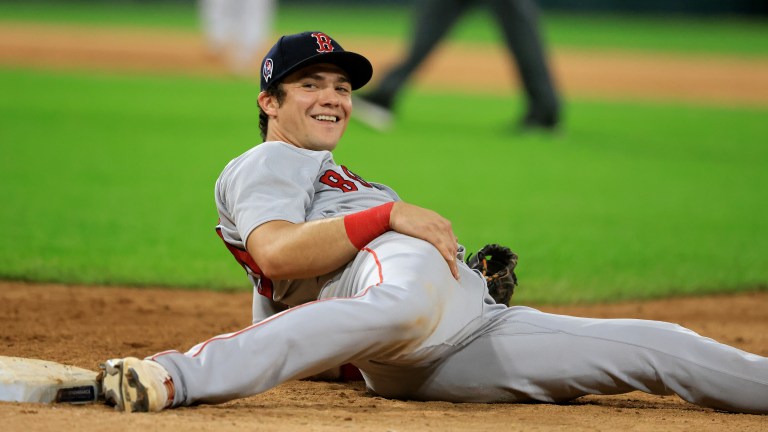MLB Second Half Breakouts: Fact or Fiction
Which MLB player breakouts are sustainable?

Baseball is a story best told over a large sample. Many players can be a superstar for 50 games, but sustained success is the ultimate goal; tides can turn very quickly at the plate. The aim of this article will be to dissect which second half breakouts are legit and which are destined for a return to earth.
Frank Schwindel – Chicago Cubs
The top three hitters by wOBA since the start of the second half are Juan Soto, Bryce Harper, and Frank Schwindel; two certified superstars and a player who was claimed off waivers by the Cubs on July 18th.
Unlike many of the other breakouts that will be mentioned in this article, Frank Schwindel is nearing 30 years of age, but that doesn’t mean we should write him off. Displaying an elite approach with only a 15% strikeout rate and 6% walk rate, Schwindel puts a ton of balls in play and can sustain a high batting average on balls in play due to hitting the ball hard on 45% of batted balls, which is equal to Rafael Devers and Jorge Soler.
Schwindel does a good job of elevating his hard contact, with an average launch angle of 11 degrees leading to 11 doubles and 12 home runs this season. His ability to elevate bodes well for sustaining a high home run to fly ball rate, which measures how often a player hits a home run per each fly ball.
Verdict: Fact
It’s unrealistic to think that Frank Schwindel will be able to sustain his current performance as a top 10 hitter in baseball, but all signs point to him being at least an average MLB first basemen with a chance at 30 home runs over a full season. Since 2015, only eight other first basemen have below a 20% K-rate and greater than a .200 isolated power; the list includes names like Anthony Rizzo, Edwin Encarnacion, Joey Votto and Freddie Freeman. He’ll be a perfect cheap option for the Cubs during their rebuild and an obvious fan favorite.
Bobby Dalbec – Boston Red Sox
Bobby D, the hardest hitting man in the land is he. That’s right, since the start of the second half, Bobby freakin Dalbec has the ninth highest hard hit rate in baseball, hitting 55% of batted balls above 95 MPH. For Dalbec, it’s never been whether he could hit the ball hard, it’s whether he could make consistent contact.
In the first half, it was clear that he was overmatched and guessing on every pitch, which led to an abysmal 37% strikeout rate and 5% walk rate. There is a lack of approach and then there is whatever that was, but Dalbec must’ve used the All-Star Break wisely because he came back a completely revolutionized hitter with a vendetta out for leather spheres.
Since the all-star break, his strikeout rate has continued to plummet and over the last month, he struck out a very manageable 28% while walking 10% of plate appearances, which is something we have never seen from Bobby before. The results of the approach adjustment have been polarizing to say the least. He’s gone from a .219 average and 76 wRC+ in the first half to a .284 average with a 160 wRC+, which ranks 14th in all of baseball in the second half.
Verdict: FACT
As I said, it’s always been a question of whether Bobby would make enough contact to squeeze value out of his elite power. The Red Sox were catching heat from fans for continuing to trot Dalbec out there amid his struggles, but as always, they know more than we do and we are now witnessing the results of giving a prospect time to adjust to MLB pitching. Pitchers always adjust quicker than hitters.
We have a saying here at Just Baseball…GIVE. THE. MAN. A SECOND.
Alejandro Kirk – Toronto Blue Jays
Standing at only 5-foot-8 with a 265 pound frame, Alejandro Kirk isn’t your traditional looking catcher. Coming into the season, Kirk was a player receiving a lot of buzz after a big year in the minors and strong showings at camp. Kirk struggled to begin the year as he dealt with a hip flexor injury that would eventually put him on the IL for almost three months, but upon his return, he has once again found his baseball mashing ways.
In 34 games since his return, he has a 125 wRC+, which ranks sixth among catchers over that span, and has only struck out 14 times while walking 11 times. It’s an approach that mirrors fellow Blue Jays top prospect, Gabriel Moreno, who we rank 9th in all of baseball, and for this reason, it’s easy to forget that Kirk is still just 22-years-old and still developing himself.
Kirk has always been known for finding barrels, and has proved that by hitting 50% of his batted balls above 95 MPH, which means they are hard hit according to Baseball Savant. Hitting balls above that threshold improves likelihood of a productive outcome and coupled with an all field approach, it is no wonder why Kirk’s xwOBA of .396 since the all star break is 15th in all of baseball.
Verdict: Fact with a Capital F
Kirk was one of my favorite hitters coming into the year and despite being hampered by an injury, has shown that he can be a hard hitting catcher in the middle of the Blue Jays lineup. At only 22 years old, Kirk has not tapped into his full power potential yet, but with time, I envision a power hitting threat that can hit 30 doubles and 30 home runs in a season. Regardless, the current version of Kirk is immensely valuable, giving the Jays a tough decision in the future on who to keep between him and Moreno.
Carter Kieboom – Washington Nationals
Carter Kieboom hasn’t exactly broke out just yet, but there may be signs that a breakout is on the horizon. For a guy hitting just .225 with an 82 wRC+ on the year, I understand that is a difficult idea to process. On the surface, nothing pops out as intriguing besides Kieboom being a former top prospect that graduated as the 26th best prospect in baseball per Fangraphs in 2020.
Digging deeper, we find that Kieboom has gotten massively unlucky in the second half. Since July 15th, Kieboom has a .301 wOBA, which is nothing to write home about, and a .375 xwOBA, which is certainly an eye catcher considering league average wOBA currently sits at .314. The most jarring discrepancy is between his wOBA on contact at .353, which is in the bottom 25% of baseball, and his xwOBA on contact at .557, which is fifth in baseball since July 15th. The baseball gods have clearly had Kieboom’s number, so seemingly it’s only a matter of time before he turns this around right? Not so fast.
Verdict: Fiction
This might come as a shock after the information I just put in front of you, and while I am very fond of all the expected stats that Baseball Savant provides us with, in a small sample, they cannot provide all the information necessary to make a complete decision. While Kieboom has clearly gotten unlucky, there are concerns with his production that extend beyond luck.
For starters, Kieboom has struggled massively against breaking pitches, hitting .232 with only two extra base hits against breaking stuff this season. Secondly, Kieboom does not elevate, posting ground ball percentages near the top of the league and on top of that, his hard hit rate of 39% is towards the middle of the pack. Finally, while the aim of this article is to asses breakouts at the plate, Kieboom is likely to be a man without a position, lacking the skills to stick at third base long term. In conclusion, there is some evidence that supports a potential breakout for Kieboom, but adjustments to his approach will need to take place before that can occur, so for the time being, Kieboom’s momentum is fiction.

